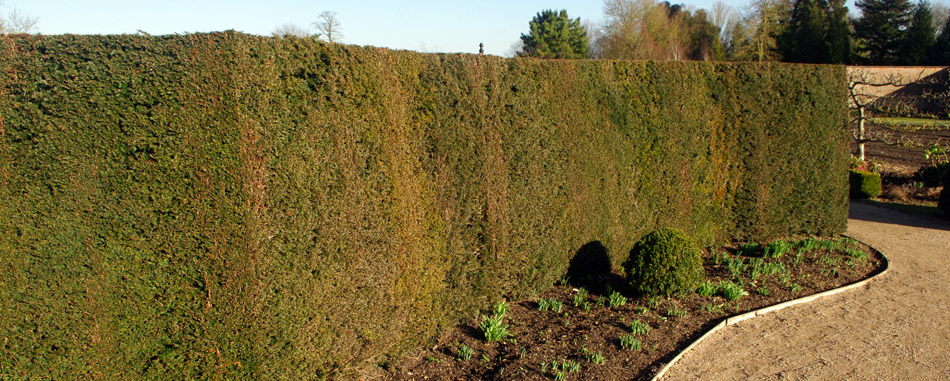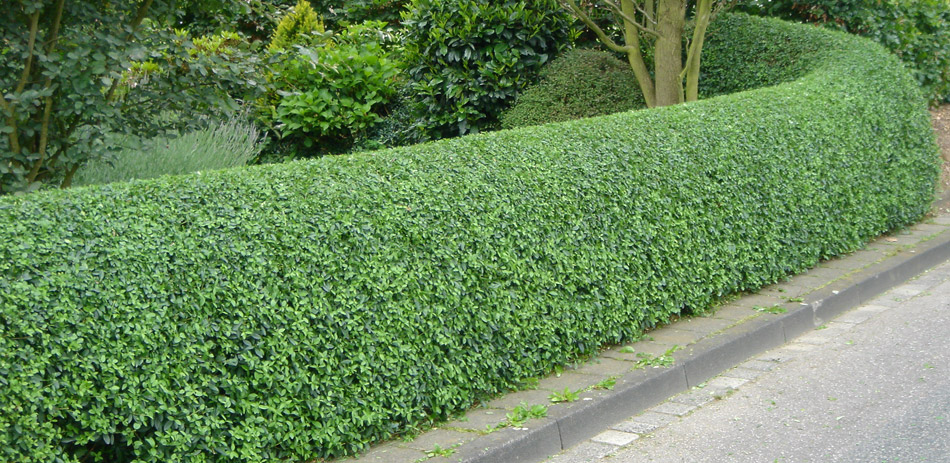Hedges and Hedging Plants
Which hedging plant to use? Care must taken in selecting the kinds of hedging plants that you use, some types take more looking after than others, they grow at different rates and have a variety of advantages and disadvantages. Almost any hardy tree or shrub could be planted as a hedge but a few types are better than the others.
 A recently trimmed mature yew
hedge, already many years old
A recently trimmed mature yew
hedge, already many years oldReality check - There is no plant that grows
quickly to the required size and then stops. They either get
there fairly quickly and keep going way
past it or are better behaved but
take time to to the right size.
Buy hedging plants
|
Formal Hedges |
||||
| Hedging plant | Planting distance | Clipped height | Clips per year | Responds to renovation? |
|
Evergreen |
||||
| Common Box, Buxus sempervivens | 30cm, 12" | 30-60cm, 1-2ft | 2 - 3 growing season | Yes |
| Lawson cypress, Chamaecyparis lawsoniana | 60cm, 24" | 1.2-2.5m,
4-8ft. can be larger |
2, spring and early autumn | No |
| Leyland cypress, Cupressocyparis lleylandii | 75cm, 30" | 2-4m,
6-12ft. can be to 6m, 20ft and beyond |
2 - 3 growing season | No |
| Escallonia | 45cm, 18" | 1.2-2.5m, 4-8ft | 1, immediately after flowering | Yes |
| Holly, Ilex aquifolium S | 30cm, 12" | 2-4m, 6-12ft | 1, late summer | Yes |
| Privet, Ligustrum | 30cm, 12" | 1.5-3m, 5-10ft | 2 - 3 growing season | Yes |
| Box honeysuckle Lonicera nitida | 30cm, 12" | 1-1.5m, 3-5ft | 2 - 3 growing season | Yes |
| Yew, Taxus baccata | 60cm, 24" | 1.2-4m, 4-12ft | 2, spring and early autumn | Yes |
|
Deciduous |
||||
| Barberry, Berberis thunbergii S | 45cm, 18" | 60cm-1.2m, 2-4ft | 1, summer | Yes |
| Hornbeam, Carpinus betulus | 45-60cm, 18-24" | 1.5-6m, 5-20ft | 1, mid to late summer | Yes |
| Hawthorn, Crataegus monogyna S | 30-45cm, 12-18" | 1.5-3m, 5-10ft | 2, summer and autumn | Yes |
| Beech, Fagus sylvatica | 30-60cm, 12-24" | 1.2-6m, 4-20ft | 1, late summer | Yes |
S - good for a security
hedge or protecting a vulnerable position (lots of vicious
thorns)
 Low hedges of dwarf box surrounding
formal flower beds
Low hedges of dwarf box surrounding
formal flower beds|
Informal and Flowering Hedges |
||||
| Hedging plant | Planting distance | Clipped height | Number of times to clip per season and when | Ornamental qualities |
|
Evergreen |
||||
| Berberis darwinii S | 45cm, 18" | 1.5-2.5m, 5-8ft | 1, immediately after flowering | yellow flowers, purple berries |
| Cotoneaster lacteus | 45-60cm, 18-24" | 1.5-2.2m, 5-7ft | 1, after fruiting | white flowers red fruits |
| Escallonia | 45cm, 18" | 1.2-2.5m, 4-8ft | 1, immediately after flowering |
white, red or pink flowers |
| Holly, Ilex aquifolium S | 30cm, 12" | 2-4m, 6-12ft | 1, late summer |
white flowers, berries |
| Lavender, Lavandula | 30cm, 12" | 0.6-1m, 2-3ft | 1, after flowering | purple flowers |
| Laurel, Prunus laurocerasus | 60cm, 2ft | 1.2-2.5m, 4-8ft can be larger | 1, after flowering | white flowers |
| Pyracantha S | 60cm, 24" | 2-3m, 6-10ft | 1, after fruiting | white flowers, red, orange or yellow berries |
|
Deciduous |
||||
| Hawthorn, Crataegus monogyna S | 30-45cm, 12-18" | 1.5-3m, 5-10ft | 2, summer and autumn |
scented white flowers, red berries |
| Shrubby cinquefoil, Potentilla fruticosa | 30-45cm, | 0.6-1.2m, 2-4ft | 1, spring | yellow flowers |
| Hedgehog Rose, Rosa rugosa S | 30-45cm, 12-18" | 1.5m, 5ft |
1, spring |
flowers and red "hips" |
| Flowering currant, Ribes sanguineum | 30-45cm, 12-18" | 1.5-2m, 5-6ft |
1, after flowering |
pink flowers |
 A well established and clipped privet
hedge
A well established and clipped privet
hedge
Size of the hedge
Along with maintenance, the ultimate size of a hedge causes the greatest concerns. In a perfect world, the hedge would grow rapidly and thickly to a preset height and then stop dead in its tracks.
The reality is that if you want a "fast " hedge, one that will grow to the desired height and thicken up just as quickly, it will tend to keep on going upwards and outwards just as vigorously past the optimum size as it did to get there in the first place.
This is the cause of the great Leylandii curse, a much misused hedging plant, particularly on housing estates in the past. They rapidly form an excellent hedge, but require regular cutting back and the subsequent disposal of large quantities of material if they are not to get out of hand or even become the subject of a dispute between neighbours.
Fast growing plants means the
hedge is effective sooner,
but then requires more maintenance
to keep it under control

Slower growing hedges will take
several years to form an effective barrier,
but will require
less clipping and will generally live longer.
Maintenance
The other major issue with hedges is the need for regular maintenance. All hedges need trimming at least once a year, some more often. Regular lighter pruning is better for the hedge, and easier to carry out, than infrequent heavy pruning, there's also a lot less material to dispose of, if it's small twiggy stuff it can be fed though a garden shredder or just mixed with grass clippings and put straight on the compost heap.
A powered hedge trimmer can be used for light pruning, this can speed up the trimming process and help to give a more uniform finish with straight lines.
Planting
The soil for a newly planted hedge should be very well prepared as the hedge will be a long term permanent feature. It should be dug over thoroughly and have a * good quantity of organic matter added to the soil.
* good quantity - an indeterminate amount, but usually much more than you first think. (if dug in - and it should be dug in) to make about 20-30% of the volume of the soil it is added to. Think "copious", it will reduce in volume with time as it settles and rots.
When the hedging plants are planted, they should also be given a dressing of bonemeal or blood, fish and bone meal, alternatively inorganic Gromore or similar could be used. It is also good practice to give them a regular feed once established in the spring, again top-dressing with a balanced fertiliser. A mulch of bark chips or similar to prevent weed growth is advisable, this does not need to be replaced or topped up in later years as it rots away, as its function is to help the plants establish early on. Watering is advisable through the first spring and summer to ensure good initial establishment of the hedging plants.
It is sometimes suggested that hedging plants be planted in double rows rather than single. This is not necessary unless a hedge is required that is wider than about a metre (39") or for purposes of establishing the hedge that little quicker. When overcrowded, plants tend just to produce the same amount of top growth spread between them as they would if planted more thinly with less plants giving the same amount of leaf cover. There is also the possibility of crowding and the accumulation of dead wood.
Formative pruning of hedges
Left to their own devices, hedges will grow upwards and become relatively "leggy", that is thin at the bottom and thicker towards the top. Care must be taken in the first few years to prune the plants so that they develop into a thick and effective hedge.
On planting - cut deciduous plants back by a third of their height. Strong laterals (side shoots) should also be cut back by one third.
Second winter - Cut back again by one third.
The trick is to prune weakly growing shoots hard and strongly growing shoots lightly. Don't be tempted to "even up" the hedge, the result will often be the opposite.
Many hedging plants will form very tall trees or shrubs if left unpruned. In general they will respond to trimming of their vertical growth by producing side shoots. Sometimes it is necessary to trim verticals in order to promote bushy sideways growth even though vertical height is also required. It is all part of the process of establishing a well formed and effective hedge.
Does the size of the hedging plants that go in matter?
Hedges establish better and form dense bushy growth from the ground upwards more readily if planted as young, small plants. You may look at the small bare rooted whips or transplants and imagine it will be years before they will achieve anything which looks like a hedge but they will be better than larger plants. If larger plants are chosen the result can be rather gappy at the base at least in the early days.
In very few years a hedge planted as small bare-rooted plants will catch up and over-take a hedge planted as much bigger and more expensive pot grown plants. Larger plants are more likely to fail than smaller ones. If you decide to plant a hedge, you need to accept that it's going to be a long term project and several years before the hedge is as you want it.
Freebies
Look out for help with hedging plants from your local council.
Don't get too hopeful, you won't get any free containerised yew or box plants to put around your pottager or make a knot garden. But a number of organizations around the country will help supply traditional native hedgerow plants (usually as 6-12" (ish) tall bare rooted whips) to help renovate a neglected hedge or start a new one.
If you have a largish wild garden or would like to begin such an area, it's well worth searching online to see what is available. What is available and who from varies from year to year the offers are often also available to schools and local organizations.
Photo credits: privet hedge: Holger Casselmann - Creative Commons Attribution 3.0 Unported license
